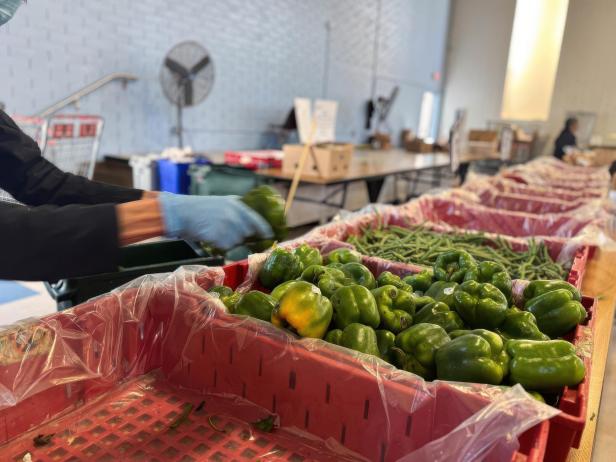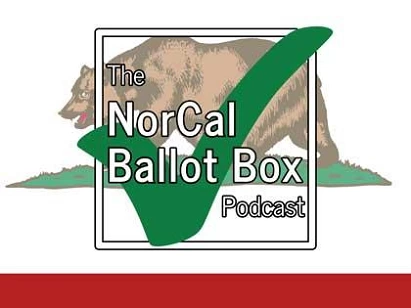 photo credit: Claire Barber/Peninsula Press
photo credit: Claire Barber/Peninsula PressVolunteers restock produce at St. Anthony's Padua dining room on Nov. 1, 2025.
Farm families can have food shortages too. In the Bay Area, some of the very people stepping up to feed families cut off from the Supplemental Nutrition Assistance Program are suffering the trickle-down impacts of the longest federal government shutdown in history.
On Tuesday, the U.S. Supreme Court granted President Donald Trump's administration an extension to withhold SNAP benefits until Thursday at 11:59 p.m., while Congress works out a deal to end the shutdown. A vote on a compromise that would reopen the government was expected in the House of Representatives on Wednesday, but there is uncertainty as to when money will flow to states to restart food assistance programs.While Bay Area local governments, food banks and other nonprofits work to feed the most vulnerable, the loss of federal dollars is also hitting local farmers.
"The Trump administration's deliberate refusal to pay SNAP benefits according to the law is hurting the whole ecosystem," said California Attorney General Rob Bonta at a press conference Monday. "That includes all those that rely on the SNAP benefits, the providers of the food, the retailers, including our farmers."
Bonta has joined dozens of other state attorneys general and governors in a two-week legal battle to require the U.S. Department of Agriculture to release full SNAP benefits, known in California as CalFresh. At various points in the saga, federal courts in Rhode Island and Massachusetts had ordered the USDA to restart partial or full payments, but their efforts have been blocked by the U.S. Supreme Court upon the request of USDA Secretary Brooke Rollins.
"With a loss of these programs due to federal delays and cuts, we are anticipating the loss of local food sales," said Andy Naja-Riese, CEO of the Agricultural Institute of Marin, a nonprofit that operates farmers markets throughout the Bay Area. "In our communities, that means less dollars that farmers are bringing back to their rural areas, less money for fertilizer, for tractors and for farm workers."
Naja-Riese said that over 80% of farms in California are small farms, and most farmers often need supplemental income through secondary jobs.
"The cost of doing business is increasing, and farmers are operating on razor-thin margins," he said.
AIM does not represent the large mass production farms that stock the shelves of grocery store chains like Safeway or Walmart. Based in Marin County, the organization manages the distribution of food directly from farmers to customers, bringing nutritious produce and dairy products to food deserts and areas where buyers don't have a lot of choices.
AIM members include over 400 small to mid-sized farmers, ranchers, fishers, dairy producers and food makers. The institute operates nine certified farmers markets across Marin County, but their member farmers also supply markets in San Francisco, Richmond, Oakland, Hayward and Newark.
Many of their customers buy food using CalFresh electronic benefit transfer or EBT cards, which are like debit cards loaded with money from the federal SNAP program. Customers swipe their EBT cards at a CalFresh booth and receive tokens. One token is worth one dollar. The average allotment of CalFresh funds per person is about $9.93 per day.
Naja-Riese said that for every dollar spent on food sold through a traditional grocery store, farmers receive up to $0.16, with the rest of that going toward distributors and marketers. However, when farmers are selling direct, they can receive up to $0.98 on the dollar.
"So, SNAP is an important way to feed people, but also it stimulates the economy. And when you take that away, it's going to depress the economy," he said.
Farmers markets also provide SNAP recipients up to $15 per day via Market Match, a government program that incentivizes the purchase of fruits and vegetables grown by California farmers. Market Match is funded with state and federal dollars and is administered through the California Department of Food and Agriculture.
For example, Naja-Riese said, if someone spends $15 of their SNAP benefits at a farmers' market, they receive an additional matching $15, bringing their spending total to $30.
"When folks come to shop at the farmer's market and use EBT and get Market Match, they spend those dollars directly with the farmers and local food makers," he said. "We've estimated that for some farmers, EBT and Market Match can be up to 30% of their sales."
"Across our markets we have about 1,250 households per week that come to the farmers market to use their EBT and receive the Market Match," said Naja-Riese. "They spend up to $40,000 per week on local foods."
Moira Kuhn operates Marin Roots Farm in west Marin County with the help of her spouse and sometimes their three children. They grow certified organic row crops, root vegetables, culinary herbs and micro greens.
"At the moment we're only doing three farmers markets a week," she said. "There's only so much time during the day. It's just the two of us, so we find it hard with a family to do multiple farmers markets in the same day."
Kuhn estimates that her row crop farm is one of a shrinking list of less than 20 in the county. Her family is not currently receiving SNAP benefits, but they have in the past.
"It felt like a life jacket," she said. "Especially with kids in the house, it's a lifeboat, it helps keep us above water. It also helps keep us healthy."
AIM also operates a mobile farmers market called Rollin' Root, which brings fresh food to neighborhoods in San Francisco and Marin County where access to fresh, healthful foods is limited, as well as communities that have older adults or limited food access.
"At our Rollin' Root mobile market, we provide half off with no limit," said Naja-Riese. "Say I have $50 I'm going to spend on my EBT card. We only charge you $25."
Naja-Riese said it is important that emergency funds go directly to people who have lost their SNAP benefits so they can continue to shop for food.
"Farmers and local food sources are part of the solution," he said. "Because in some cases, like in West Marin, there's very few places to shop for food."

 Live Radio
Live Radio




